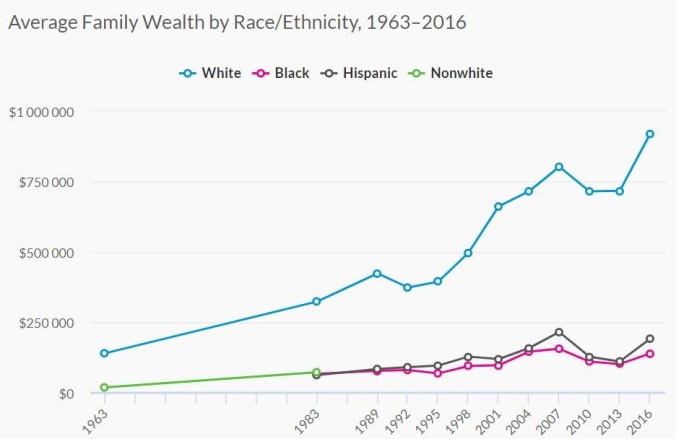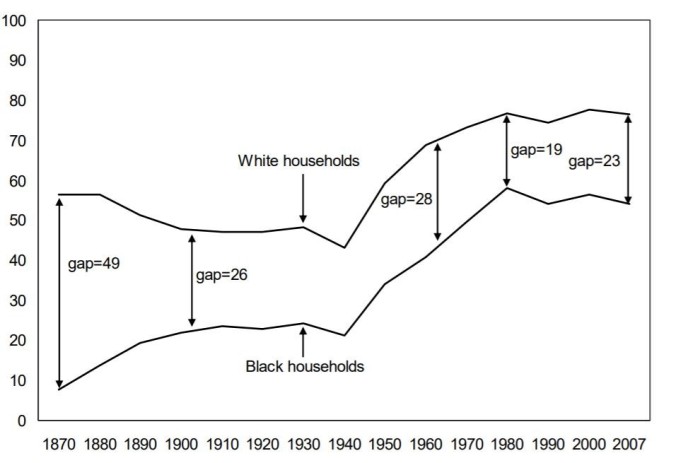Sometimes, slavery is offered as an explanation for African American poverty rates. At first glance, this seems like a absurd explanation since without slavery African Americans would simply be Africans, and would no doubt be poorer than they currently are. Of course, people who say that slavery explains Black poverty do not mean “explanation” in the normal sense. They don’t suppose that Black poverty would be lesser had slavery simply not occurred. Rather, what they mean is that Black poverty would be lesser if African Americans had all been transported to America as free people instead of as slaves. Of course, this would not have happened in the real world, but we are encouraged to ignore this fact when discussion the causes of black poverty.
This is unjustifiable, but for the sake argument let’s consider the question of whether African Americans would be significantly richer today had they been brought to America as free people.
The mechanisms by which slavery is often said to have retarded black economic progress is through inhibiting black education, by destroying the Black family, and by stopping Black Americans from accumulating wealth which they could transfer to their offspring. None of this stands up to empirical scrutiny.
The best evidence on the effects of slavery come from comparisons of the descendants of free blacks and those who were enslaved. Beginning soon after emancipation, those black people who were freed from slavery were less literate, and poorer, than black people who were born free. This difference persisted for some time, but after two generations the descendants of enslaved and free black Americans did not statistically differ in terms of both education and economic success (Sacerdote, 2002). This suggests that the effects of slavery had largely faded by the time we get to the grandchildren of slaves and makes it highly improbable that such effects still linger today.
This may seem surprising, but it is consistent with other data on the inter-generational effects of wealth in 19th century America and in the South. For instance, Bleakley and Ferrie (2013) found that the decedents of those who won Georgia’s land-lottery in the 1830s fared no better for it in terms of their income, wealth, and literacy rates. Analyzing the opposite sort of event, Ager et al. (2016) looked at data on those whose wealth was destroyed during the civil war due to slave emancipation and war related property destruction. Based on this analysis, they estimate that a person’s wealth being decimated by 10% predicted a 0.4% decrease in their children’s income. By the next generation, this effect probably wouldn’t significantly differ from zero. It certainly would not differ from zero for those born 100 years later.
This isn’t all that different from what modern studies find, especially among African Americans. For instance, Toney (2016) finds that a 10% increase in wealth among an American’s grandparents predicts a 1.8% increase in their own wealth if they are white and a 0.2% increase in wealth if they are Black.

More strikingly, research shows that black children born to parents in the top fifth of the income distribution are equally likely to occupy the top and bottom fifth of the income distribution when they grow up. By contrast, white children born into the top economic quintile are far more likely to stay there than fall to the bottom (Chetty et al., 2018).
The speed with which wealth fades across African American generations today gives us even greater reason to doubt that differences in wealth from 150 years ago are still persisting in effect.
This may seem like a surprisingly short period of time in which to expect the effects of major events to vanish. However, this is similar to, or greater than, the amount of time it seemingly took, for instance, the Irish to rebound from extreme repression by the English, Jewish people to fully rise economically following emancipation, Japan to rebound following WW2, and countries like Estonia to recover from communism. In general, it seems not unusual for populations to recover from great acts of oppression or exploitation within a few generations of the ending of that oppression or exploitation.
More broadly, it is the case that environmental effects on people decay fairly quickly once the relevant environmental stimuli are removed. For instance, childhood interventions aimed at improving general cognitive abilities by giving children special educational attention, improved nutrition, and giving their parents classes in how to parent better, improve cognitive ability in the short run but this effect fades out after the intervention ends such that they have no long term effect (Protzko, 2015). The same is found for more targeted interventions which aim, for instance, at improving children’s language abilities by reading with them (Noble et al., 2018).
People often over-estimate the persistence of environmental effects because children resemble their parents even well into adulthood and group differences often persist across generations. In the case of families, we know that this is an illusion created by genetics. For instance, Hyytinen et al. (2013) contains a review of 19 previous twin studies. On the basis of this literature, it was shown that variation in income in the United States is 41% due to genetics, 9% due to the childhood home environment, and 50% due to other factors (which technically includes certain special sorts of genetic factors, measurement error, random luck, etc., as well as the non-home environment). Parents and offspring share roughly half of their genes and thus the correlation between parents and offspring in income is mostly explained by genes.
Moreover, there are several studies showing that people born into rich families end up having higher incomes, while the income of the family a person is adopted into has no effect on their income as an adult (Sacerdote, 2002; Sacerdote 2004).
Thus, there is little, if any, non genetically-mediated transmission of wealth and income even within a single generation. This gives us even greater to doubt that the economic effects of slavery could persist to the current day.
Sometime, it is noted that black families were broken when kin were sold to separate slave owners and this is said to explain modern rates of single parenthood among blacks. The idea that black people today leave their children because their ancestors from the 1860s or before, who they have never met, were forcibly separated from their family is totally without evidence. The idea that these forces explain modern black family structure is down right implausible since black rates of single parenthood are far greater today than they were in the 19th century.

This brings us to yet another reason to doubt that the effects of slavery are still in the process of being eliminated: if this were true than the effects of slavery should be marginally lesser each generation and so we should see slow and steady economic improvements among African Americans. Nothing like this has taken place for the last half century.
A 2017 Federal Reserve report shows that white and Black working women had roughly equal wages in the 1970s and 1980s, but since the 90s a gap has appeared which favors white women. For males, there was already a wage gap present in the 1970s and it is even greater today.

Now, with respect to males many authors make the mistake of looking at the wages only of working men, neglecting the impact that changes in unemployment and incarceration rates have on average earnings. This is also a problem for the analysis of trends among females, but it is less severe. Bayer and Charles (2017) correct for this and make a striking finding: the difference between the median white and median black male worker in earnings is larger today than it was in 1940.

With respect to net wealth, the situation similar but more extreme. Since the 1960s, the Black-White Wealth gap has increased many times over.

Turning to employment, as shown in Fairline and Sundstrom (1999), the Black-White unemployment gap appeared sometime in the 1940s and has massively widened since then.

With respect to home ownership, the trajectory is perhaps even more surprising. Collins and Margo (2011) show that the Black-White home ownership gap is today similar to what it was in 1910.

And the rate of poverty among African Americans stopped declining in the 1960s, and actually began to rise thereafter if you exclude welfare payments when calculating income (“latent poverty”).

Nothing in any of this data looks like African Americans are slowly recovering from the economic effects of slavery. This, combined with the direct data comparing the descendants of free and enslaved blacks, and the historical and contemporary data on the inter generational transfer of wealth, and the historical recovery time for other populations following important hardships, gives us good reason to reject the view that slavery is an important cause of modern Black poverty rates.
Pingback: Inheritance and Racial Inequality | Ideas and Data
Pingback: Vaush: Ultimate Research Document 2.0 | Race & Conflicts